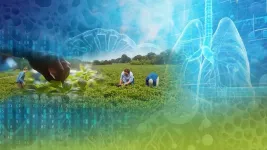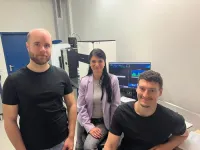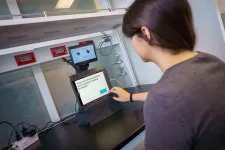One bad apple spoils the barrel: New study uncovers multiple molecular subgroups in liver cancer with most aggressive driving clinical outcomes
2024-06-24
(Press-News.org)
Singapore, 24 June 2024 – A study led by clinician-scientists and scientists from the National Cancer Centre Singapore (NCCS) and A*STAR’s Genome Institute of Singapore (GIS) and funded by the National Research Foundation Singapore (NRF) has discovered unexpected molecular heterogeneity even within the same liver tumours. More than 40% of HCC harbours more than one molecular subtype within the same tumour and in these, the clinical outcomes for the patients are best predicted by the most aggressive subtype. This phenomenon, termed the “bad apple effect”, has significant implications on the understanding of liver cancer and suggests that a more holistic sampling of liver cancer tumours, is needed to improve the way the disease is studied and treated to optimise patient outcomes. These new findings were published in the Journal of Hepatology on 21 May 2024.
In Singapore, liver cancer is the third most common cause of cancer deaths in males and fifth most common cause in females[1]. HCC, the most common type of primary liver cancer, is the only common solid organ cancer without any validated predictive biomarkers. This means that doctors are unable to use molecular biomarkers to determine which drug is best for an individual patient with HCC. This is one of the reasons why treatment is less effective compared to other common cancers. The case-fatality ratio of HCC today is 0.92—the highest amongst all cancers in Asians.[2]
To address this unmet clinical need and improve the treatment of HCC, the PLANet study (Precision Medicine in Liver Cancer across an Asia-Pacific Network), analysed over 600 tumour and adjacent normal samples that were surgically resected from 123 HCC patients from Singapore, Malaysia, Thailand and the Philippines. Samples were analysed using multi-regional sampling approach that enables deep profiling of genomic and cellular heterogeneity within each tumour to evaluate their impact on disease progression. This study is supported by NRF under the National Medical Research Council (NMRC) Open Fund-Large Collaborative Grant and administered by the Singapore Ministry of Health through the NMRC Office, MOH Holdings Pte Ltd.
The team found that there was unexpected intratumoural heterogeneity in the HCC transcriptome, also known as the RNA transcript, which determines the behaviour of tumour cells. This indicates that the current practice of obtaining a single sample from liver cancer tumours under-represents the complexity of the tumour significantly and limits a comprehensive understanding of the entire tumour ecosystem. This heterogeneity may explain why developing therapeutics for HCC is a challenge as it cannot be treated by a one-size-fits all approach.
The second key finding was that more than 40% of HCC samples analysed harboured more than one transcriptomic subtype. Of these, the subtype with the worse prognosis determined each individual patient’s clinical trajectory and outcome. This is the first time this “bad apple effect” has ever been shown in HCC. The team also found that early and late tumour evolution characteristics were important in predicting patients’ survival.
“Uncovering the “bad apple effect” in liver cancer progression has generated an important blueprint for HCC that can be used to improve the treatment of the disease. Our study shows a comprehensive landscape of evolutionary history of the disease and is a rich resource for understanding tumour heterogeneity and clinical progression,” said Professor Pierce Chow, Corresponding Principal Investigator of PLANet 2.0, senior author of the study and Senior Consultant Surgeon, Division of Surgery and Surgical Oncology, Singapore General Hospital and NCCS.
“The application of genomic technologies has enabled us to produce a high-resolution map of the different cell types that co-exist within the same tumour. Now, clinicians are able to pinpoint the specific cell populations which have a more deterministic role in driving the disease and develop therapeutic approaches to target the more aggressive cells in future,” said Associate Professor Tam Wai Leong, Theme PI of PLANet 2.0, co-senior author of the study and Deputy Executive Director at A*STAR’s GIS.
The group received a S$25 million grant to conduct PLANet 2.0, under the NMRC Open Fund-Large Collaborative Grant programme in 2022, and now includes collaborators from A*STAR’s Institute of Molecular and Cell Biology and Duke-NUS Medical School. The team has continued their studies by using a spatial transcriptomics and spatial metabolomics approach in two therapeutic studies to understand the HCC microenvironment. This approach has found that co-localisation of biomarkers is important to the biology of HCC and will be key to making progress in the development and discovery of novel and more effective treatments for HCC.
[1] National Registry of Diseases Office. (2023, Aug). Singapore Cancer Registry Annual Report 2021.
[2] Rumgay H, Arnold M, Ferlay J, Lesi O, Cabasag CJ, Vignat J, et al. Global burden of primary liver cancer in 2020 and predictions to 2040. J Hepatol. 2022 Dec;77(6):1598–606.
END
ELSE PRESS RELEASES FROM THIS DATE:
2024-06-24
New Haven, Conn. — Rising health care prices in the U.S. are leading employers outside the health care sector to reduce their payroll and decrease their number of employees, according to a new study co-authored by Yale economist Zack Cooper.
The study, published June 24 as a working paper by the National Bureau of Economic Research (NBER), found that when health care prices increased, non-health care employers responded by reducing their payroll and cutting the jobs of middle-class workers. For the average county, a 1% increase in health ...
2024-06-24
Press materials are now available for NUTRITION 2024, the annual flagship meeting of the American Society for Nutrition (ASN). Top nutrition scientists and practitioners from around the world will gather to share the latest research findings on food and nutrition during the meeting, held in Chicago from June 29–July 2.
Register for a press pass to attend NUTRITION 2024 in person or to access embargoed press materials before the meeting. Explore the meeting schedule, poster presentations, poster theater flash sessions and oral presentations to see all the exciting research ...
2024-06-24
Ann Arbor, June 24, 2024 – Alcohol consumption is involved in a large proportion of homicides and suicides each year in the United States, but there has been limited evidence on how policies targeting alcohol use influence violence. A statistical analysis in the American Journal of Preventive Medicine, published by Elsevier, indicates that more restrictive alcohol policy environments are associated with a reduction in specific states’ homicide rates.
Lead investigator James P. Murphy, PhD, RAND Corporation, Santa Monica, CA, says, "Previous studies have found a significant relationship between some state-level ...
2024-06-24
The stereotype of mathematics and mathematicians involves a solitary pursuit of knowledge, but Eric Stachura knows better.
The Kennesaw State University assistant professor of mathematics works on quantitative analysis of electromagnetic waves and keeps a collaborative research practice with colleagues near and far. That partnership has led to a three-year grant worth $223,206 from the Army Research Office, a director of the U.S. Army Combat Capabilities Development Command Army Research Laboratory.
“It is a very collaborative subject, ...
2024-06-24
The National Institutes of Health (NIH) has partnered with the U.S. National Science Foundation (NSF) to provide approximately $15.4 million over three years for research into the structures, functions and interactions of ribonucleic acid (RNA), as well as the creation of RNA-based technologies. RNA sequencing and the mapping of RNA modifications have gained significant momentum in the genomics community in recent years, with a new report from the National Academies of Sciences, Engineering, and Medicine outlining a roadmap for the field to build technology and infrastructure to allow researchers to more completely study and catalog RNA and its modifications.
“A ...
2024-06-24
INDIANAPOLIS – One of the first studies to examine patient acceptability of teleneurology and determine factors influencing acceptability across neurological conditions, has found teleneurology was highly acceptable across the full range of patients with different neurological diagnoses, including headache, movement disorders and other neurological symptoms and diagnoses. The study also determined that the more medical complexity -- having additional diseases -- was associated with increased patient satisfaction with teleneurology.
Older patients were as accepting of teleneurology as younger patients, individuals often viewed as more ...
2024-06-24
Image generator models – systems that produce new images based on textual descriptions – have become a common and well-known phenomenon in the past year. Their continuous improvement, largely relying on developments in the field of artificial intelligence, makes them an important resource in various fields.
To achieve good results, these models are trained on vast amounts of image-text pairs – for example, matching the text "picture of a dog" to a picture of a dog, repeated millions of times. Through this training, ...
2024-06-24
The function of non-coding RNA in the cell has long been a mystery to researchers. Unlike coding RNA, non-coding RNA does not produce proteins – yet it exists in large quantities. A research team from the University of Göttingen has now discovered an important function of antisense RNA (asRNA): the researchers found that asRNA acts as a "superhighway" in cell transport and thus accelerates gene expression. The results were published in Nature.
RNA (ribonucleic acid) plays a central role in the translation of DNA information into proteins. There are different types of RNA, one of which is known as messenger ...
2024-06-24
Video: https://youtu.be/bGKA32TlVXM?si=0PdhaUyOKH33DFbB
Meet CARMEN, short for Cognitively Assistive Robot for Motivation and Neurorehabilitation–a small, tabletop robot designed to help people with mild cognitive impairment (MCI) learn skills to improve memory, attention, and executive functioning at home.
Unlike other robots in this space, CARMEN was developed by the research team at the University of California San Diego in collaboration with clinicians, people with MCI, and their care partners. To the best of the researchers’ knowledge, CARMEN is also the only robot that teaches compensatory cognitive strategies to help improve memory and executive function.
“We ...
2024-06-24
New York University has established the Center for Mind, Ethics, and Policy, which aims to further our understanding of the sentience and moral status of nonhumans, notably animals and AI systems.
“The world contains quintillions of animals, and in the future, it could contain an even larger number of AI systems,” says Jeff Sebo, CMEP’s founding director and a professor in NYU’s Department of Environmental Studies. “Human activity is increasingly shaping the lives of these beings, and these trends raise important and difficult questions, such as: Which of these beings are sentient, ...
LAST 30 PRESS RELEASES:
[Press-News.org] One bad apple spoils the barrel: New study uncovers multiple molecular subgroups in liver cancer with most aggressive driving clinical outcomes



